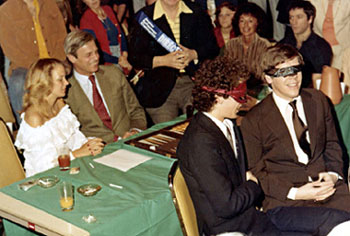|
| Magriel's NYT Columns |

Roger Low and Paul Magriel play blindfolded
in a demonstration match with
Denise Hemingway and George Plimpton In the last five years, the enormous growth in popularity of backgammon has resulted in many significant theoretical advances. Even though the game is thousands of years old, many fundamental concepts have only recently been discovered. A new generation of talented young players is spearheading this advance.
Foremost among this new breed is 21-year-old Roger Low. His play combines exceptional analytical ability with a tough competitive spirit. He alone, among all the world’s best players, seems to have the uncanny capacity to effortlessly remember whole series of games roll-by-roll and move-by-move. This same capacity has helped make him the uncontested top player in the world of blindfold backgammon.
After attending Cornell University, where he learned to play, he is now on Wall Street, training to be a broker, so that he can divide his time between playing on the backgammon board and on the Big Board.
|
| Black to play 1-1. |
Low discovered a better play, which many players would have overlooked — 24/23*, 16/14, 16/15. Again Black hits with his first 1 and then breaks his 16-point, but now he intentionally leaves two blots in White’s outfield.
|
|
|
The additional danger incurred by leaving two blots is minimal. Surprisingly, the probability of being hit is only slightly increased (8 chances out of a possible 36, instead of 7) by this play. (Note that the duplication principle is at work here: White needs 2’s and 3’s to reenter and 2’s and 3’s to hit.) Even if White does reenter and hit, Black has little to fear because he has the security of owning the 20-point and the prospect of return shots at White’s blot on the 21-point.
Rollout
 Tom Keith 2013 |
|
Money play Centered cube Black rolls 1-1 1296 games with VR Checker play: 2-ply Cube play: 3-ply Red |
| 1-1: | Game | G | BG | Equity | ||||
| 1 | 24/23*, 16/15, 16/14 |
W L |
.5939 .4061 |
.1790 .1024 |
.0086 .0046 | +0.4198 |

| (b) |
| 2 | 24/23*, 16/13 |
W L |
.5852 .4148 |
.1755 .1024 |
.0083 .0041 | +0.3849 | (0.0349) | (a) |

|
|

